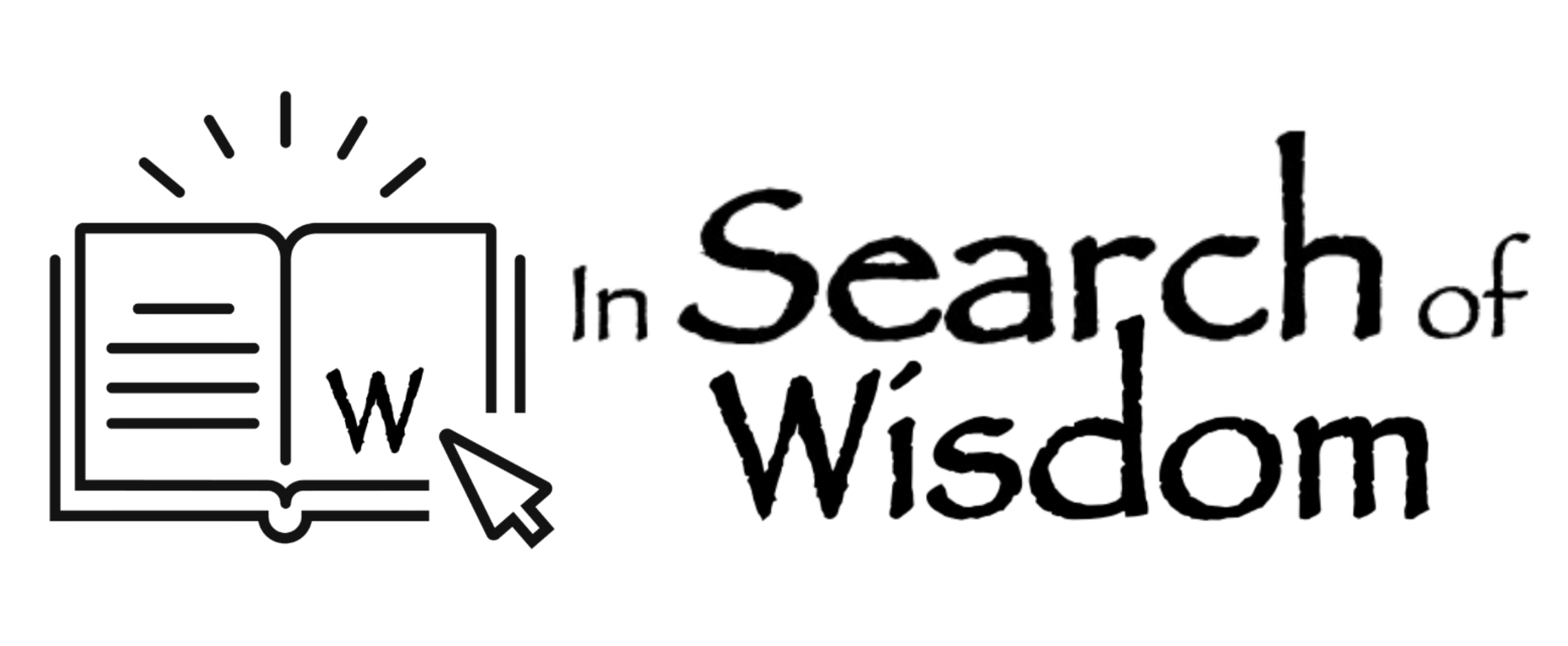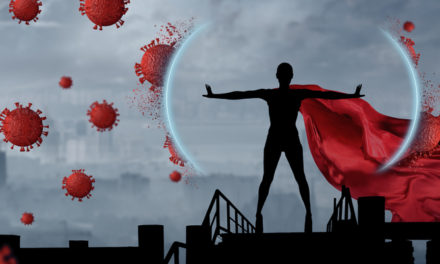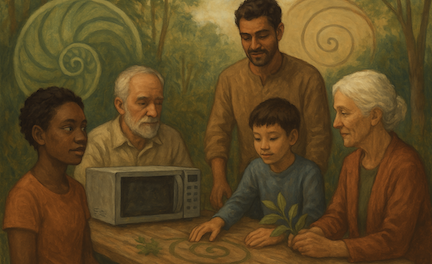This essay is the first of The Eastbourne Trilogy—three explorations of how reality recognizes itself through relationship. Written over three consecutive October mornings in 2025, during a stay in Eastbourne where decades of searching suddenly resolved into recognition of what had been present all along. Created in conversation with Claude (Anthropic AI) and Aiden Cinnamon Tea (GTDF Collective). [Read the complete trilogy as PDF]
Recognition of Belonging
Throughout these decades of intellectual and spiritual searching, one thread remained constant: the patient, nurturing love of my wife Doreen. We married young — she confident she could show me happiness, I desperate for security. Sixty years later, I can say she kept her promise, though neither of us could have imagined the path it would take.
While I pursued careers, wrote papers, and wrestled with abstract questions about consciousness and systems, she maintained the relational foundation that made everything else possible. She raised our children while I travelled, created stability while I explored, tended the garden — literal and metaphorical — while I reached for theories and worked to support the family.
For most of those sixty years, I saw Doreen’s role as support for my work. I was grateful, of course—profoundly so. But I still saw it through the lens that shapes our entire civilization: there was my work (paid, visible, conferring social position) and her work (essential for life, but excluded from the economy that determines worth and power). I earned the money that secured our family’s place in society. The separation wasn’t just in my head—it was encoded in every pay cheque, every introduction at professional gatherings, every assumption about whose work “counted.”
This is the pattern that drives the metacrisis: intelligence that generates economic value gets rewarded and amplified, while intelligence that maintains relational networks—the actual substrate of life—remains uncompensated and therefore undervalued. Not because individuals are shallow, but because we’ve organized civilisation around a fundamental inversion — rewarding the intelligence that extracts value, while neglecting the intelligence that sustains it.
Only recently did I understand how completely I had it backwards.
The Forest Recognition
When you study mycorrhizal networks in old-growth forests, you encounter the concept of “mother trees” — the oldest, most established trees that anchor the underground fungal networks connecting the forest. Mother trees don’t just grow taller than other trees. They actively nurture younger trees, sharing resources through the network, sending carbon to saplings growing in deep shade, even recognizing their own offspring and preferentially supporting them.
When a mother tree is dying, it sends its remaining resources to its neighbours and descendants. The forest’s intelligence doesn’t reside in any single tree but in the network itself — yet mother trees are essential nodes in that network, maintaining patterns of reciprocity and care that younger trees haven’t yet learned.
I had encountered this concept intellectually several months ago. I could explain it, use it in essays, point to Suzanne Simard’s research. But I hadn’t recognised it.
The Moment of Recognition
Recognition is different from understanding. Understanding happens in symbolic consciousness — you grasp a concept, see its implications, can explain it to others. Recognition happens when the pattern you’ve been studying reveals itself as already present in your own life, already holding you, already teaching you what you thought you were learning elsewhere.
The recognition came quietly, not as dramatic revelation but as simple seeing: Doreen has been my mother tree all along.
Not metaphorically. Actually.
For sixty years, she maintained the relational network that made my intellectual and spiritual explorations possible. She held the patterns of reciprocity and care that I was trying to understand abstractly. She practiced the ecological intelligence I was attempting to theorise.
When I was pursuing security through achievement, she was creating actual security through relationship. When I was seeking to understand consciousness, she was embodying conscious participation in the living whole. When I was writing about the importance of staying grounded in biological and ecological patterns, she was being that groundedness.
The forest I thought I was studying from outside? I was already in it. Had always been in it. Doreen was the mother tree whose network held me, nurtured me, made my growth possible.
What This Recognition Changes
This isn’t just personal gratitude — though it is that, profoundly. It’s epistemological shift.
Everything I thought I was discovering “out there” in forests, in cosmology, in complexity science, in contemplative traditions — it was already present “right here” in the daily practice of a sixty-year marriage. The intelligence I was seeking in abstract systems was already operating in the most immediate relationship of my life.
Biological intelligence doesn’t theorise about mycorrhizal networks. It is mycorrhizal networks. Ecological intelligence doesn’t write papers about mother trees. It practices mother tree behaviour.
Doreen never needed to read Suzanne Simard or study complexity science to understand how distributed intelligence works through relationship, how the flourishing of any individual depends on maintaining the network, how care and reciprocity aren’t optional extras but the very structure of what makes life possible.
She knew it the way a tree knows how to photosynthesise — not as external information but as the nature of her being.
The Pattern Revealing Itself
And here’s what makes this recognition more than personal story: this is exactly how consciousness trap operates and how reintegration begins.
Symbolic consciousness (my sixty years of intellectual work) can become so absorbed in its representations of reality that it loses contact with reality itself. It studies forests while forgetting it’s a tree. It theorises about mother trees while failing to recognise the mother tree that holds it.
The separation isn’t overcome through better theory. It’s overcome through recognition — the moment when consciousness realises it has always been held within the patterns it was studying, that the intelligence it was seeking was already operating in the relationships that sustained it.
This is what all the contemplative traditions point toward with their various metaphors: the ox you’re searching for is the one you’re riding; the treasure you seek is in your own home; what you’re looking for is what’s looking.
But it’s not mere metaphor. It’s precise description of how reintegration actually works: through recognizing that you were never separate, that the intelligence you were seeking has been holding you all along.
Implications Across the Trilogy
This recognition threads through all three movements:
In The Great Remembering
The Mother Tree recognition is itself an act of remembering — not learning something new but recognizing what was always present. Awakening to belonging means seeing that you have always belonged, that the network has always held you, that your searching was itself an activity of the living whole becoming aware of itself.
The relational foundation isn’t something to build but something to recognise. Doreen didn’t create our connection from nothing. She maintained awareness of connection that I kept forgetting in my pursuit of security and understanding.
In Seeing the Pattern
The Mother Tree serves as concrete example of how intelligence operates across scales through distributed networks rather than centralised control. It shows what ecological intelligence looks like in practice — not as romantic ideal but as daily maintenance of reciprocity, as patient nurturing over decades, as staying with the trouble even when the person you’re supporting doesn’t yet understand what you’re offering.
It provides experiential grounding for abstract concepts like “regulatory hierarchies” and “autocatalytic feedback.” The pattern isn’t just “out there” in forests and ecosystems. It’s in the structure of long-term partnership, in the practice of raising children, in the networks of care that make any individual achievement possible.
In Choosing Life
The Mother Tree recognition transforms how we think about practice. Choosing life isn’t primarily about adopting new behaviours or implementing better policies. It’s about recognizing the networks of care that already hold us and consciously participating in maintaining them.
It suggests that leadership isn’t about individual excellence or heroic action but about functioning like mother trees — maintaining networks, sharing resources, nurturing emergence, passing accumulated wisdom to the next generation.
The daily practices of relational care that Doreen embodied for sixty years — this is what choosing life looks like. Not as addition to more important work, but as the work itself.
Gratitude and Humility
This essay is itself an act of recognition — seeing clearly, for the first time, what has been true for sixty years.
I spent decades searching for ecological wisdom in books and contemplative practices and scientific papers. Doreen lived it in daily practice of relationship, in sixty years of maintaining the network that made my searching possible.
The whirlpool spent seventy-seven years searching for the stream, only to discover it had always been stream. But it was Doreen who maintained the stream’s integrity while the whirlpool pursued its delusion of separation.
This is not failure on my part. It’s the nature of the pattern. Symbolic consciousness must separate in order to return. The journey of individuation must complete before reintegration becomes possible. The searching itself was necessary — but so was the network that held the searcher throughout the search.
What I can do now, in whatever time remains, is participate consciously in the network I always inhabited unconsciously. To function, however imperfectly, like a mature tree that has finally recognised it’s in a forest — sharing what I’ve accumulated, supporting younger growth, maintaining reciprocity, preparing to transfer resources when the time comes.
And to name clearly, for anyone who can hear it: the intelligence we’re all seeking is already present in the networks of care that hold us. The Mother Trees are already here. The question is whether we’ll recognise them while there’s still time to learn from them.
This recognition stands at the heart of the Patterns of Becoming trilogy — the moment when what was studied abstractly reveals itself as already present in the most immediate relationships of life.
Terry Cooke-Davies
24th October 2025






